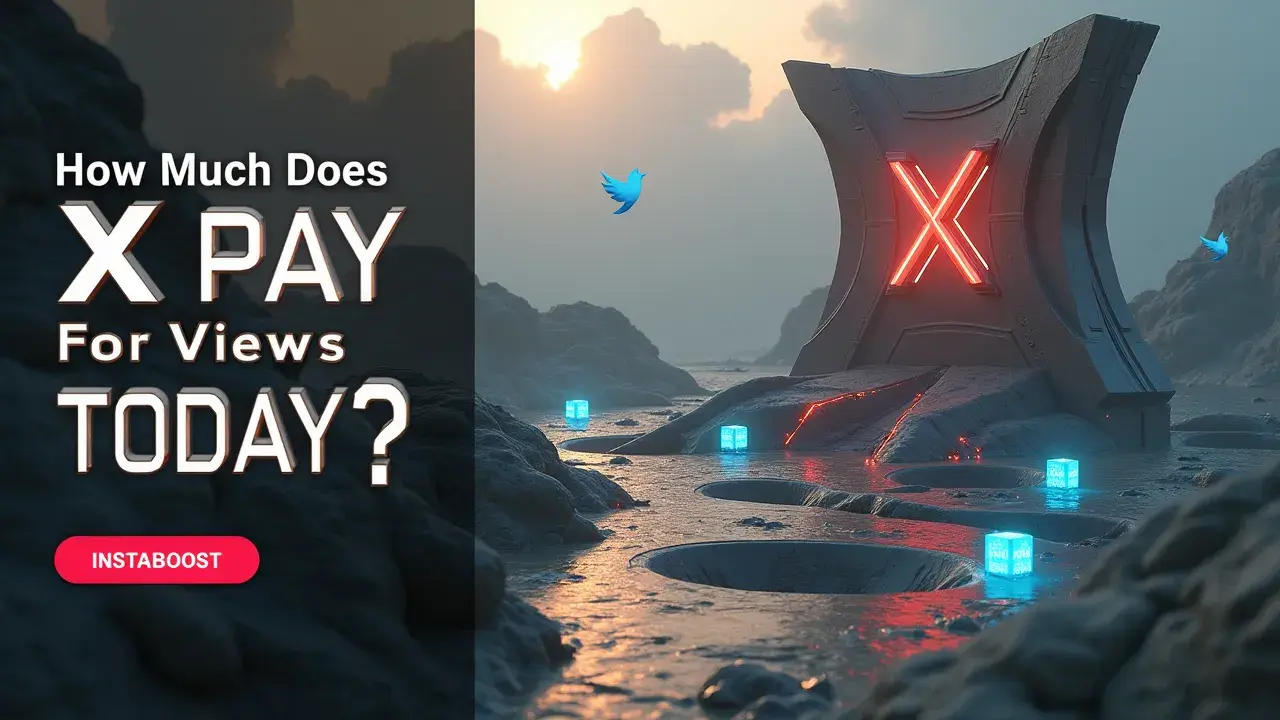How Much Does X (Twitter) Pay for Views Today?
Payouts for views on X (Twitter) hinge on engagement quality rather than raw impressions. What the audience does after clicking matters, and stable retention typically outperforms short-lived spikes. Track view-to-engagement ratios, then compare day-one and day-three earnings to judge whether today’s rate is meaningfully different. The smart path is consistent content that sustains attention and aligns timing with when audiences respond best.
Why “Pay per View” on X Isn’t What It Sounds Like
If you’re asking how much X pays for views today, you’re really asking what X rewards after the view, because the revenue share follows attention quality, not raw counts. Two posts with 100,000 views can earn very different payouts based on retention, replies, profile visits, and whether those viewers come back for a second or third touch. Treat views as a top-of-funnel signal and optimize for the behaviors X’s ad and revenue-share models actually value: longer watch time, real comments, follow-through clicks, and session depth, and consider using reputable tools to engage audience on X in ways that complement organic traction.
That’s why creators who pair strong hooks with clean analytics and targeted promotion tend to see steadier earnings than those who chase spikes – they’re building sessions advertisers want to be in. If you add paid accelerants, use reputable placements, cap them with safeguards like frequency limits and audience exclusions, and judge them by view-to-engagement ratio and day-one versus day-three RPM, not vanity impressions.
Creator collabs can also lift payouts when they match audience intent and spark authentic conversation. The headline number for how much X pays for views shifts with ad demand and geography, but your controllable levers are consistent: match topics to buyer interest, frontload retention, and keep a tight testing loop so you can cut what draws empty traffic. The non-obvious edge is timing – posting when your core segment is primed to interact can raise effective CPM more than adding another 10,000 passive eyeballs. In short, you can nudge today’s rate up if your views are designed to convert into time spent and meaningful engagement.
Creator collabs can also lift payouts when they match audience intent and spark authentic conversation. The headline number for how much X pays for views shifts with ad demand and geography, but your controllable levers are consistent: match topics to buyer interest, frontload retention, and keep a tight testing loop so you can cut what draws empty traffic. The non-obvious edge is timing – posting when your core segment is primed to interact can raise effective CPM more than adding another 10,000 passive eyeballs. In short, you can nudge today’s rate up if your views are designed to convert into time spent and meaningful engagement.

Signals That Actually Move Your Payout
Here’s the trap even sharp marketers hit: they benchmark “how much X pays for views today” from screenshots and CPM guesses, then chase volume instead of the behaviors that unlock revenue share. The platform pays after attention proves itself – longer watch time on videos, comments that spark threads, profile taps that lead to follows, and session depth that keeps people on-platform. If two posts reach 100,000 impressions, the one with 20 – 30% longer retention and genuine replies will usually out-earn the flashier spike. Treat it like conversion rate optimization for attention. Pair strong hooks with mid-roll value, ask for concrete responses instead of generic emojis, and use creator collabs to cross-seed audiences that actually engage.
Paid acceleration works when it’s targeted and reputable, creating early momentum – match it to audience intent and measure second-touch actions, not just cost per view. Keep a clean analytics loop: track view-to-engagement ratios, day-one versus day-three earnings, and which formats compound session depth. A practical cadence is two tests per week per format – short video, thread, image post – with one variable changed each time. Fold in qualified tools to engage audience on X when they complement organic traction and meet safeguards like transparent sourcing and compliance, and avoid low-quality boosts that inflate vanity impressions without retention signals.
The core insight is simple: the same “view” is priced differently by the algorithm based on what happens in the next 30 seconds. If you design for the follow-up moment – comment prompts, mid-thread cliffhangers, end-cards that drive profile visits – “pay per view” starts to behave like “pay per sustained behavior,” and your rate improves accordingly.
Design for Actions, Not Eyeballs
If your plan only works under perfect conditions, it isn’t a plan. Treat “how much does X pay for views today” like a conversion problem and design each post to spark behaviors that compound payout. Open with a tight hook and keep an early promise – front-load value in the first three seconds, then add intrigue to lift average watch time and thread depth. Ask for one specific action per post – reply with a take, tap for the full clip, or check the profile for the resource – so you can see which nudges lift session duration. Match format to intent. Use short native video to earn retention signals, a clean image-plus-text to spark replies, then a follow-up quote-reply to recirculate the conversation.
Collaborate with creators whose audiences overlap your topic so replies feel organic, not bolted on. Targeted promotion can speed this up when it’s reputable, time-boxed, and measured – use small spend to reach likely engagers, not broad reach, and watch how day-one retention maps to day-three earnings. Keep a testing loop. Track view-to-engagement ratios, reply quality, profile taps per 1,000 impressions, and repeat viewers. If a post under-delivers, salvage it with a clarifying reply or a tighter caption. If it over-performs, spin a mini-series to extend session depth.
Tools that help you engage audience on X can be a smart lever when they emphasize real comments, safe growth, and clean analytics – avoid boosting vanity metrics that dilute your signal. The non-obvious upside is that a smaller audience that reliably stacks watch time and threaded replies often out-earns a larger, colder one, because X pays after attention demonstrates intent, not before and quick likes on Twitter.
Stop Chasing CPM Screenshots
I was told this would pass. It didn’t. The hidden cost of asking “how much does X pay for views today” is treating views like currency instead of a diagnostic. If a post with 100,000 impressions underpaid, look at what happened after second three – did people scrub, bounce, or leave substantive comments? Platforms reward what deepens session time, not vanity spikes.
So instead of flooding more posts or stacking cheap promotion, shift to a quality-matched plan. Open with a tight hook and keep the promise, add a mid-video micro-payoff, and ask for one specific action that signals intent, like replying with an example, tapping to see part two, or following for the teardown. Targeted promotion still works when it accelerates real retention rather than masking decay – think creator collabs that bring context-rich viewers, not broad traffic.
Use clean analytics and a 72-hour testing loop. Compare watch-time percentiles, reply-to-like ratios, and engagement views for X and day-one vs day-three revenue to see whether a higher impression count actually lifted payout. If you buy ads, buy from reputable sources with frequency caps and audience fit, and hold them to induced retention, not just clickthrough. The contrarian insight is that the same view can be worth 3 – 5x more when it drives thread depth and profile taps, so design for behaviors that stack. Treat every post as a conversion path – hook, proof, interaction, handoff – so the algorithm sees proof of value and pays accordingly. That turns “how much does X pay for views today” from a guessing game into an optimization problem tied to retention signals, real comments, and early momentum that compounds.
Cash Follows the Behavior You Engineer
This wasn’t a bow. It was a breadcrumb. If you want a real answer to how much X pays for views today, skip the rate calculators and build a repeatable loop. Open strong, pay off early, and give people clear reasons to stick, react, and return. Treat views as the top of a conversion ladder with rungs like retention, rewatches, shares, real comments, and a click-through to a next action you control. Accelerants work when they’re matched to intent.
A targeted promotion can nudge early momentum, creator collabs can borrow trust, and fast retweet delivery can complement light paid testing to help you find the first three seconds that lift average watch time. Reputable tools give you clean analytics, while low-quality boosts muddy the signal and can suppress session depth. If a post underperforms at 100,000 impressions, study the curve after second three and the thread depth after comment two. Platforms tend to pay the content that expands session time and drives meaningful interactions. Anchor a testing loop. A/B hooks, swap thumbnails, iterate captions that seed genuine replies, and measure day-one versus day-three earnings to see whether you built compounding retention or a vanity spike.
The non-obvious lever is asking for one specific behavior per post and designing the piece for that micro-outcome – save, reply with context, or click to a follow-up – because focused intent creates cleaner signals the algorithm can amplify. When you align topic-market fit with a clear next step, pair it with early momentum, and add safeguards against junk traffic, the question “how much does X pay for views today” shifts to “how reliably can I convert attention this week,” which is the only rate that matters and the one you can raise.















